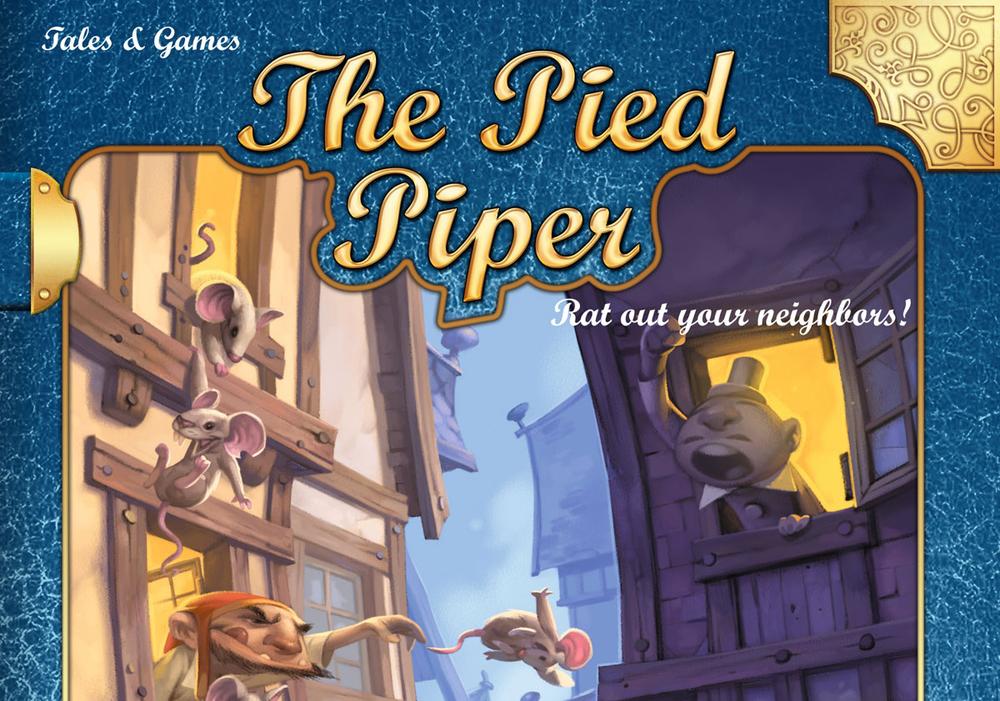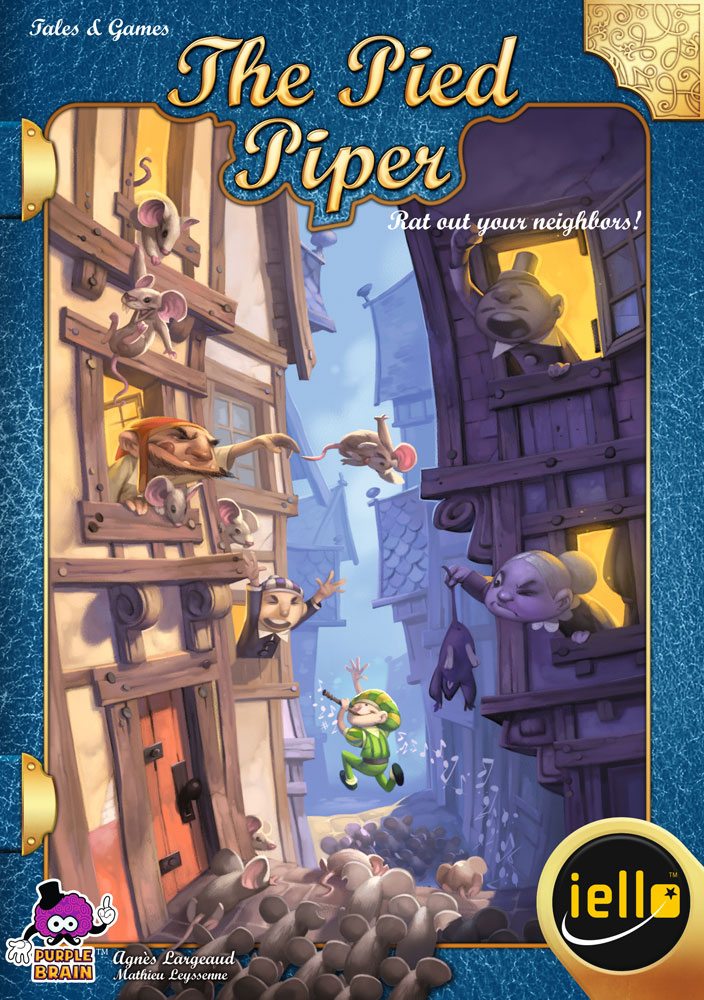Hamelin is overrun with rats—and only the Pied Piper is able to lure them away. In this Tales & Games title from Iello Games, you and your opponents are citizens of Hamelin, trying to rid your home of rats—and the best way to do that is to send them to somebody else’s house.
At a glance: The Pied Piper is a game for 2 to 5 players, ages 8 and up, and takes about 20 minutes to play. It retails for $24.99 and is available online or in stores. It’s family-friendly, with a mix of luck and strategy; there is player elimination, but the game itself is fairly short so eliminated players won’t be sitting out for too long.
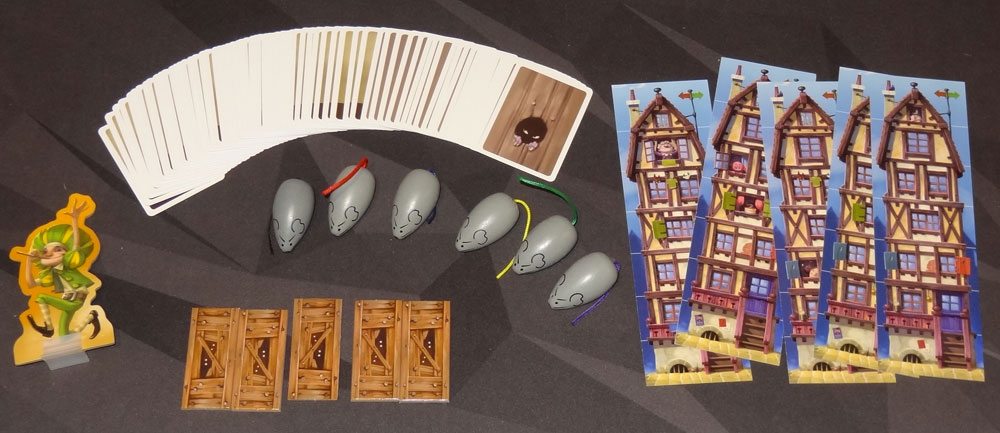
Components
- 5 House boards
- 5 Rat tracker tokens
- 6 Rats
- 1 Pied Piper standee
- 21 Character cards
- 50 Action cards
As with the other Tales & Games titles, The Pied Piper comes with a little booklet containing the story itself, and the box is designed to look like a hardcover book, with a magnetic clasp for the lid.
The house boards are narrow cardstock, with an illustration of a house divided into 7 levels; they look a little like bookmarks. The rat trackers are small cardboard rectangles—they look like a boarded up area, with little eyes peeking out—and they track how far up your house the rats have gotten. The rats themselves are little wooden rats with painted faces, and each has a string tail of a different color. The Pied Piper is a cardboard cutout with a plastic base, and the cards are mini-sized cards.
All of the components are pretty nice and the divider is well-made to hold everything, though I always find mini cards a little hard to shuffle.

How to Play
The rulebook is available for download here.
The goal of the game is to be the last house overrun with rats.
To set up, each player takes a house and rat tracker (which starts just below the house). Place one rat between each pair of houses, and then add a second rat and the Pied Piper to the left of the start player. The remaining rats (and their corresponding Character cards) are removed and put back into the box. The rest of the Character cards are shuffled together to form a deck and the first four cards are turned face-up in a row in the center of the table (with a max of one Pied Piper card showing during the initial setup). The Action cards are shuffled, and each player gets four.
On your turn, you play two Action cards from your hand below two of the Character cards—however, the first player only plays one card on the very first turn. (You may not play them both below the same card.) After playing both cards, if any Character card has two Action cards below it, it is activated. You move the corresponding figurine as noted by the Action cards—the top one first, then the bottom one. Then that Character card and its Action cards are discarded, and another Character card is drawn to replace it. You draw back up at the end of your turn.
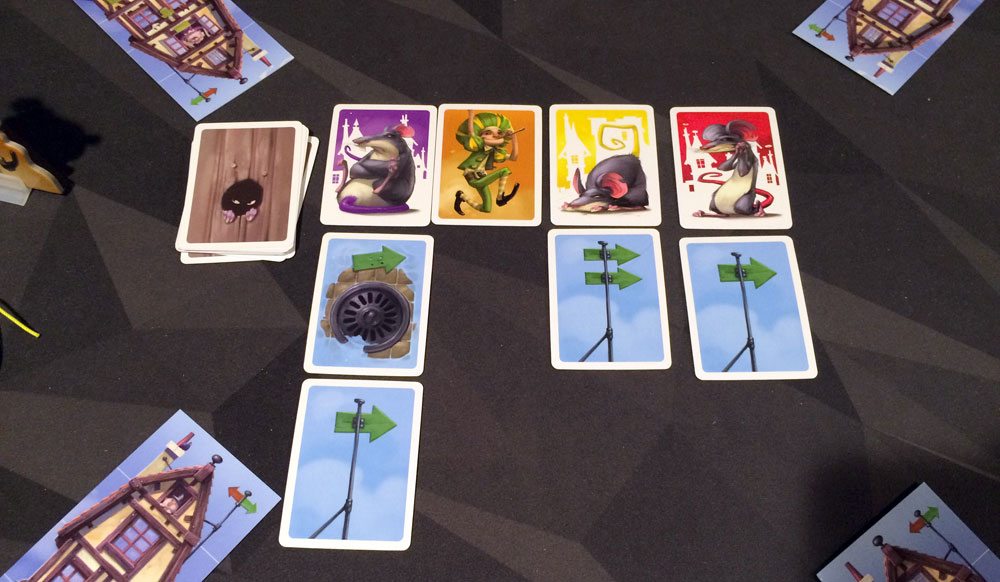
There are various action cards:
- Move 1 space to the right
- Move 2 spaces to the right
- Move 1 space to the left
- Move 1 space to the right through the sewers
- Add 1 to the movement
- Melody: all other figurines in this location move together
Whenever a rat passes through your house, the rat tracker moves up one space. When the Pied Piper moves through your house, the rat tracker moves down one space. A figurine that moves through the sewers past your house has no effect on your house.
As soon as the rat tracker reaches the top of your house, you flee from your house and are eliminated. Your house is immediately removed from the game, and the rat tracker is given to the active player as a trophy (along with any rat trackers you may have collected as trophies).
The game continues until there are 2 players left. Whoever has the lower rat tracker wins; ties are broken by the number of rat tracker trophies.
There are a few variant rules in the rulebook, too.
The “Rugrats” variant for younger player eliminates the “+1” and Melody Action cards, and also moves the figurines as soon as a single card is played rather than when two are played. (However, you still discard and replace the Character card as soon as there are two Action cards below it.)
There’s also another variant, “A Happy Life Is a Secret Life,” where you may play one of your Action cards face-down. It is revealed when the Character is activated. This one adds a little bit of mystery to the game, and you have to guess what another player may be trying to do with a particular figurine.
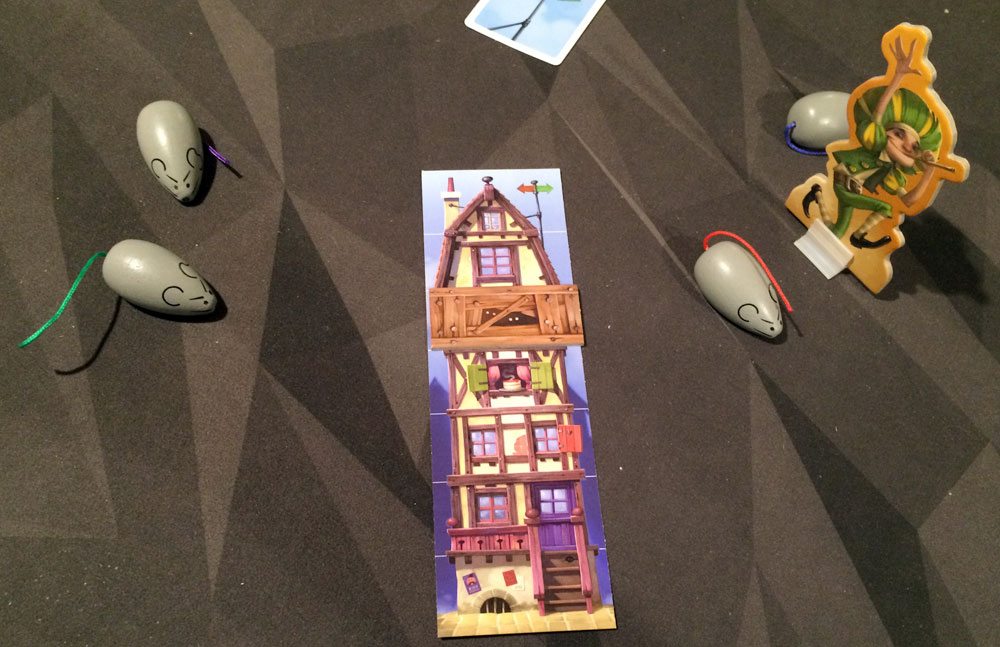
The Verdict
The Pied Piper is a clever little game, though one that I’ll play mostly with my kids and less with my adult gamer friends—though with adults I’d recommend using the “Secret Life” variant to add a little more hidden information. My kids and I had fun sending the rats back and forth and trying to out-maneuver each other.
There are some pretty interesting aspects to it: for instance, because there are three Character cards for each figurine, sometimes even when it looks like it’s inevitable that a particular rat is going to run through your home, you might be able to divert it by playing cards on the other Character card first. Or, perhaps you’ll be able to maneuver the Pied Piper together with the rat, to cancel out its effect.
The Melody card is also powerful, because if you play it at the right time, you can overrun a house very quickly, moving a pile of rats at a time, or perhaps sending a few rats with the Pied Piper so that it doesn’t bring the rat tracker back down. Using the sewer Action cards effectively can pass on a rat without affecting your own house.
The key, of course, is that it takes two Action cards to trigger a figurine, but you may only play one per Character on your turn. So either you complete a move that somebody else started, or you start a move that somebody else will likely finish. The Melody and +1 cards are particularly dependent on other players, because they only work in conjunction with another movement card. Two Melody cards will have no effect, because the character isn’t moving at all.
One thing that tends to confuse new players at first (especially kids, who get all excited about choosing their favorite color of rat) is that you don’t actually choose player colors. You get a house, and there are a bunch of different rats running around that everyone shares control of. Another thing that seemed a little odd to me, thematically, is that despite this being based on the Pied Piper story, the Pied Piper doesn’t actually solve the rat problem in the game—in fact, the problem gets so bad that everyone moves out when their houses are overrun. But I guess that means the game doesn’t have to address the uncomfortable child abduction portion of the tale, so that’s probably a good thing.
Overall, The Pied Piper is a nice game for families and casual gamers. It may not be quite as satisfying for the hardcore gamers in your group, but I think can be a good pick for those who enjoy the folk tales theme. I actually haven’t played the other titles in the Tales & Games series from Iello, but it’s a fun idea to combine stories and games in a little book-box, and I think it looks like a good collection for family gaming.
Disclosure: I received a review copy of this game.
